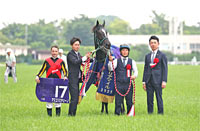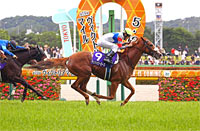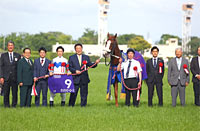Victoria Mile (G1) - Data Analysis
Ultimate contest for older fillies/mares of the spring season that has been won by a long line of historic names
Last year’s Victoria Mile winner Songline had triumphed in the 2022 Yasuda Kinen, which - like the Victoria Mile - is a 1,600m turf race held at Tokyo Racecourse. In addition, 2022 winner Sodashi had secured victories in the 2020 Hanshin Juvenile Fillies and the 2021 Oka Sho (Japanese 1000 Guineas), while 2021 winner Gran Alegria had won four JRA G1 races and 2020 winner Almond Eye six domestic or overseas G1 races. Which runner will dominate the race that determines the older filly/mare champion of the spring season and has been consistently won by historic names in recent years? Let’s now analyze some features shared by successful runners in this race based on results over the last 10 years.
Runners that have won their previous race fare poorly
Of the 30 Top 3 finishers over the last 10 years, 18 had finished 2nd-5th in their previous race. Meanwhile, runners that had finished 1st as well as those that had finished 6th or lower last time out struggled somewhat with Top 3 ratios of 7.7% and 12.2%, respectively. In other words, success ratios have been low not only for runners that have not finished in the Top 5 of their previous race, but also for runners that have won their previous race, and we should take this into consideration when comparing runners’ finish in the previous race. [Table 1]
[Table 1] Performance by finish in previous race (last 10 years)
| Finish in previous race |
Performance
[1st-2nd-3rd-4th or lower] |
Win ratio |
Top 2 ratio |
Top 3 ratio |
| 1st |
0-3-0-36 |
0% |
7.7% |
7.7% |
| 2nd-5th |
4-6-8-44 |
6.5% |
16.1% |
29.0% |
| 6th or lower |
6-1-2-65 |
8.1% |
9.5% |
12.2% |
Focus on jockeys who have performed well
Looking at performances by jockey over the last 10 years, we observe that a total of five jockeys have secured numerous Top 3 finishes in the race, falling into two groups: Christophe Lemaire and Keita Tosaki (five times each), and Hayato Yoshida, Damian Lane, and Hideaki Miyuki (twice each). Among the two jockeys with the most Top 3 finishes, Christophe Lemaire is expected to take time off in late April, leaving Keita Tosaki as the main jockey to watch if he participates in the race. [Table 2]
[Table 2] Performance by jockey (last 10 years)
| Jockey |
Performance
[1st-2nd-3rd-4th or lower] |
Win ratio |
Top 2 ratio |
Top 3 ratio |
| Christophe Lemaire |
3-1-1-3 |
37.5% |
50.0% |
62.5% |
| Keita Tosaki |
3-0-2-4 |
33.3% |
33.3% |
55.6% |
| Hayato Yoshida |
1-1-0-3 |
20.0% |
40.0% |
40.0% |
| Damian Lane |
1-1-0-2 |
25.0% |
50.0% |
50.0% |
| Hideaki Miyuki |
1-0-1-1 |
33.3% |
33.3% |
66.7% |
Focus on runners with 15 or fewer career starts
Of the 21 Top 3 finishers over the last seven years, 18 had 15 or fewer career starts. Conversely, runners with 16 or more career starts struggled with a Top 3 ratio of 7.0%. Up to 2016, there had also been many strong showings by runners with 16 or more career starts, but if trends in recent years are anything to go by, we should lower our expectations of runners with long careers. [Table 3]
[Table 3] Performance by total career starts (last seven years)
| Total career starts |
Performance
[1st-2nd-3rd-4th or lower] |
Win ratio |
Top 2 ratio |
Top 3 ratio |
| 15 or fewer |
7-6-5-60 |
9.0% |
16.7% |
23.1% |
| 16 or more |
0-1-2-40 |
0% |
2.3% |
7.0% |
In recent years, runners with Top 2 finishes in a G1 race since the previous year have enjoyed success
Of the 12 Top 3 finishers over the last four years, 10 had experience of finishing in the Top 2 of a JRA G1 race with a distance below 2,200m since the previous year. Conversely, runners without such experience struggled with a Top 3 ratio of 4.2%. If trends in recent years are anything to go by, we need to discount runners that have not achieved a Top 2 finish in a G1 race with a distance below 2,200m since the previous year. [Table 4]
[Table 4] Performance by experience of finishing in the Top 2 of a JRA G1 race with a distance below 2,200m since the previous year (last four years)
| Experience |
Performance
[1st-2nd-3rd-4th or lower] |
Win ratio |
Top 2 ratio |
Top 3 ratio |
| Yes |
4-2-4-10 |
20.0% |
30.0% |
50.0% |
| No |
0-2-0-46 |
0% |
4.2% |
4.2% |
Runners coming from a G1 race have turned in strong performance
Of the 12 Top 3 finishers over the last four years, eight had contested a G1 race or overseas graded race last time out. Conversely, runners that had contested a race other than a G1 race or overseas graded race struggled with a Top 3 ratio of 8.2%. We should accordingly raise our expectations of runners that are either coming from a G1 race or returning from abroad. [Table 5]
[Table 5] Performance by previous race (last four years)
| Previous race |
Performance
[1st-2nd-3rd-4th or lower] |
Win ratio |
Top 2 ratio |
Top 3 ratio |
| G1 race or overseas graded race |
4-1-3-11 |
21.1% |
26.3% |
42.1% |
| Other race |
0-3-1-45 |
0% |
6.1% |
8.2% |
In addition, of the four runners that finished in the Top 3 despite not having contested a G1 race or overseas graded race last time out, three had experience of finishing in the Top 2 of a counter-clockwise JRA graded race held in the same year. In other words, runners who did not contest a G1 race or overseas graded race last time out, and who also do not have experience of finishing in the Top 2 of a counter-clockwise JRA graded race since the turn of the year, are unlikely to chase the top places. [Table 6]
[Table 6] Among runners who did not contest a G1 race or overseas graded race last time out, performance by experience of finishing in the Top 2 of a counter-clockwise JRA graded race held in the same year (last four years)
| Experience |
Performance
[1st-2nd-3rd-4th or lower] |
Win ratio |
Top 2 ratio |
Top 3 ratio |
| Yes |
0-2-1-4 |
0% |
28.6% |
42.9% |
| No |
0-1-0-41 |
0% |
2.4% |
2.4% |
Seek out the winner!
Watch runners with proven track record and strong distance aptitude
The last four winners all had experience of winning a JRA G1 turf race contested over a distance of 1,600m. This suggests we should carefully consider runners’ track record and distance aptitude. Other shared features among the four runners were that they all had 13 or fewer career starts, and that they had won a JRA G1 race with a distance below 2,200m since the previous year. In other words, we should also take into account the trends shown in tables 3 and 4. [Table 7]
[Table 7] Winners’ highest finish in a JRA G1 turf race contested over a distance of 1,600m, total career starts, and highest finish in a JRA G1 race with a distance below 2,200m since the previous year (last four years)
| Year |
Winner |
Highest finish in JRA G1 turf
race contested over distance of
1,600m |
Total career
starts |
Highest finish in JRA G1 race
with distance below 2,200m
since previous year |
| 2020 |
Almond Eye |
1st (2018 Oka Sho [Japanese 1000 Guineas]) |
11 |
1st (2019 Tenno Sho [Autumn]) |
| 2021 |
Gran Alegria |
1st (2020 Mile Championship, etc.) |
11 |
1st (2020 Mile Championship, etc.) |
| 2022 |
Sodashi |
1st (2021 Oka Sho [Japanese 1000 Guineas], etc.) |
10 |
1st (2021 Oka Sho [Japanese 1000 Guineas]) |
| 2023 |
Songline |
1st (2022 Yasuda Kinen) |
13 |
1st (2022 Yasuda Kinen) |
(Masaya Ibuki)
|

- Preview
- Barrier draw
- Past performances of runners

- News
- Race result
- Video
- 2025 English

- 2024 English

- 2023 English

- 2022 English

- 2021 English

- 2020 English

- 2019 English

- 2018 English

- 2017 English

- 2016 English

- 2015 English

- 2014 English

- 2013 English

- Photo Gallery
2025 Winner: Ascoli Piceno


2024 Winner: Ten Happy Rose


|



















